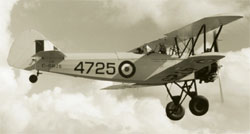
News
A Look Back: The Fleet Finch
The 16B Finch was the outcome of the original Consolidated Fleet primary trainer and was built especially for the RCAF’s Elementary Flying Training Schools.
October 2, 2007 By Raymond Canon
 So many aircraft of foreign origin have served in Canada that it is
So many aircraft of foreign origin have served in Canada that it is
fitting to call attention to one of the first of domestic origin
produced in quantity by a company that supplied both its own aircraft
and aircraft parts. The company, Fleet Aircraft of Fort Erie, Ontario
is still in operation but currently acts as a fringe supplier.
The company had been designing and producing light training aircraft in
the 1930s for both military and civil operators; these were of such
quality that they attracted buyers in no fewer than nine foreign
countries. The 16B Finch was the outcome of the original Consolidated
Fleet primary trainer and was built especially for the RCAF’s
Elementary Flying Training Schools, set up as part of the British
Commonwealth Air Training Plan. There it served beside the better known
and more widely used de Havilland Tiger Moth which had originated in
Britain even before the genesis of the Finch.
More than 400
Finch 16Bs were produced for the RCAF. Accounts of the exact number
vary slightly, but we can safely say that at least 430 of the robust
aircraft found their way into the hands of fledgling pilots starting
their training early in the war. It took only a few cold days before
both the instructors and the student pilots experienced ample evidence
that open cockpits were not suited for the rigours of Canadian winters;
flyers were soon doing their training more comfortably under a hastily
developed sliding cockpit.
No fewer than 12 of the EFTSs,
including No. 9 at St. Catharines, Ontario and No. 11 at Cap-de-la-
Madeleine, Quebec saw use of the Finch which by this time was fully
cleared for aerobatics. The airport at St. Catharines is still operated
by the city; it did not suffer the fate of so many of the wartime
military bases used to train pilots under the BCATP.
The Finch,
too, has survived the ravages of time and the original triangle runway
pattern is still in use, the only change being a lengthening of 06/24
to 5,000 feet to accomodate business jets.